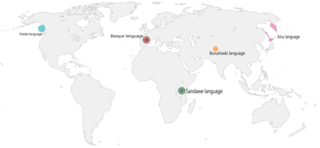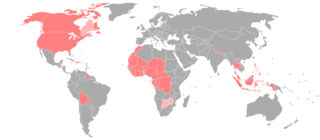Related Research Articles

Sign languages are languages that use the visual-manual modality to convey meaning, instead of spoken words. Sign languages are expressed through manual articulation in combination with non-manual markers. Sign languages are full-fledged natural languages with their own grammar and lexicon. Sign languages are not universal and are usually not mutually intelligible, although there are also similarities among different sign languages.

Hearing loss is a partial or total inability to hear. Hearing loss may be present at birth or acquired at any time afterwards. Hearing loss may occur in one or both ears. In children, hearing problems can affect the ability to acquire spoken language, and in adults it can create difficulties with social interaction and at work. Hearing loss can be temporary or permanent. Hearing loss related to age usually affects both ears and is due to cochlear hair cell loss. In some people, particularly older people, hearing loss can result in loneliness.

A language isolate is a language that has no demonstrable genetic relationship with another language. Basque in Europe, Ainu in Asia, Sandawe in Africa, Haida and Zuni in North America, Kanoê in South America, and Tiwi in Australia are all examples of language isolates. The exact number of language isolates is yet unknown due to insufficient data on several languages.

A cochlear implant (CI) is a surgically implanted neuroprosthesis that provides a person who has moderate-to-profound sensorineural hearing loss with sound perception. With the help of therapy, cochlear implants may allow for improved speech understanding in both quiet and noisy environments. A CI bypasses acoustic hearing by direct electrical stimulation of the auditory nerve. Through everyday listening and auditory training, cochlear implants allow both children and adults to learn to interpret those signals as speech and sound.
Lip reading, also known as speechreading, is a technique of understanding a limited range of speech by visually interpreting the movements of the lips, face and tongue without sound. Estimates of the range of lip reading vary, with some figures as low as 30% because lip reading relies on context, language knowledge, and any residual hearing. Although lip reading is used most extensively by deaf and hard-of-hearing people, most people with normal hearing process some speech information from sight of the moving mouth.
Adamorobe Sign Language or AdaSL is a village sign language used in Adamorobe, an Akan village in eastern Ghana. It is used by about 30 deaf and 1370 hearing people (2003).
Home sign is a gestural communication system, often invented spontaneously by a deaf child who lacks accessible linguistic input. Home sign systems often arise in families where a deaf child is raised by hearing parents and is isolated from the Deaf community. Because the deaf child does not receive signed or spoken language input, these children are referred to as linguistically isolated.
Simultaneous communication, SimCom, or sign supported speech (SSS) is a technique sometimes used by deaf, hard-of-hearing or hearing sign language users in which both a spoken language and a manual variant of that language are used simultaneously. While the idea of communicating using two modes of language seems ideal in a hearing/deaf setting, in practice the two languages are rarely relayed perfectly. Often the native language of the user is the language that is strongest, while the non-native language degrades in clarity. In an educational environment this is particularly difficult for deaf children as a majority of teachers who teach the deaf are hearing. Results from surveys taken indicate that communication for students is indeed signing, and that the signing leans more toward English rather than ASL.

Thai Sign Language (TSL), or Modern Standard Thai Sign Language (MSTSL), is the national sign language of Thailand's deaf community and is used in most parts of the country by the 20 percent of the estimated 56,000 pre-linguistically deaf people who go to school.
Iranian Sign Language (ISL) is the sign language used by Deaf and hard-of-hearing people in Iran. It is a true sign language, unlike the Baghcheban phonetic hand alphabet, which is a form of cued speech.
Bimodal bilingualism is an individual or community's bilingual competency in at least one oral language and at least one sign language, which utilize two different modalities. An oral language consists of a vocal-aural modality versus a signed language which consists of a visual-spatial modality. A substantial number of bimodal bilinguals are children of deaf adults (CODA) or other hearing people who learn sign language for various reasons. Deaf people as a group have their own sign language(s) and culture that is referred to as Deaf, but invariably live within a larger hearing culture with its own oral language. Thus, "most deaf people are bilingual to some extent in [an oral] language in some form". In discussions of multilingualism in the United States, bimodal bilingualism and bimodal bilinguals have often not been mentioned or even considered. This is in part because American Sign Language, the predominant sign language used in the U.S., only began to be acknowledged as a natural language in the 1960s. However, bimodal bilinguals share many of the same traits as traditional bilinguals, as well as differing in some interesting ways, due to the unique characteristics of the Deaf community. Bimodal bilinguals also experience similar neurological benefits as do unimodal bilinguals, with significantly increased grey matter in various brain areas and evidence of increased plasticity as well as neuroprotective advantages that can help slow or even prevent the onset of age-related cognitive diseases, such as Alzheimer's and dementia.
Singapore Sign Language, or SgSL, is the native sign language used by the deaf and hard of hearing in Singapore, developed over six decades since the setting up of the first school for the Deaf in 1954. Since Singapore's independence in 1965, the Singapore deaf community has had to adapt to many linguistic changes. Today, the local deaf community recognises Singapore Sign Language (SgSL) as a reflection of Singapore's diverse culture. SgSL is influenced by Shanghainese Sign Language (SSL), American Sign Language (ASL), Signing Exact English (SEE-II) and locally developed signs.
A village sign language, or village sign, also known as a shared sign language, is a local indigenous sign language used by both deaf and hearing in an area with a high incidence of congenital deafness. Meir et al. define a village sign language as one which "arise[s] in an existing, relatively insular community into which a number of deaf children are born." The term "rural sign language" refers to almost the same concept. In many cases, the sign language is known throughout the community by a large portion of the hearing population. These languages generally include signs derived from gestures used by the hearing population, so that neighboring village sign languages may be lexically similar without being actually related, due to local similarities in cultural gestures which preceded the sign languages. Most village sign languages are endangered due to the spread of formal education for the deaf, which use or generate deaf-community sign languages, such as a national or foreign sign language.
Alipur Sign Language is a village sign language of India. It is spoken in the town of Alipur, Karnataka, a Shia Muslim enclave with a high degree of congenital deafness. There are between 150 and 250 deaf people in Alipur, and there are approximately 10,000 hearing people speaking the language on a population of 26,000. The language has no official status and deaf children receive no formal education. This fact plus the increasing influence of the Indian Sign Language threaten the survival of Alipur Sign Language. Sibaji Panda was the first person to officially document the language in 2012.
The Arab sign-language family is a family of sign languages spread across the Arab Middle East. Its extent is not yet known, because only some of the sign languages in the region have been compared.

American Sign Language (ASL) developed in the United States, starting as a blend of local sign languages and French Sign Language (FSL). Local varieties have developed in many countries, but there is little research on which should be considered dialects of ASL and which have diverged to the point of being distinct languages.
Language deprivation in deaf and hard-of-hearing children is a delay in language development that occurs when sufficient exposure to language, spoken or signed, is not provided in the first few years of a deaf or hard of hearing child's life, often called the critical or sensitive period. Early intervention, parental involvement, and other resources all work to prevent language deprivation. Children who experience limited access to language—spoken or signed—may not develop the necessary skills to successfully assimilate into the academic learning environment. There are various educational approaches for teaching deaf and hard of hearing individuals. Decisions about language instruction is dependent upon a number of factors including extent of hearing loss, availability of programs, and family dynamics.
Deafness in Bangladesh is a major health issue. About 9.6% of the population of Bangladesh, is deaf or hard of hearing. Hearing loss in any degree is present in 34.6% of the population, and profound hearing loss is present in 1.2% of the population. The sign language used in Bangladesh is called Bangla Sign Language (BdSL). Deaf people in Bangladesh often do not have access to treatment or education, and commonly face discrimination. There are many Deaf associations in Bangladesh.
Japanese Sign Language (JSL), also known as Nihon Shuwa, is the unofficial but most predominantly used sign language used by nearly 57,000 native signers as their primary language. It is a convergent, Deaf community sign language developed in the late 19th century.
Deafness in Thailand refers to the population and culture of Deaf Hard of Hearing people in Thailand. Deafness in Thailand includes language emergence, organizations, healthcare, employment, schooling, and civil rights.
References
- ↑ Ban Khor Sign Language at Ethnologue (25th ed., 2022)

- 1 2 Nonaka 2004.
- 1 2 Nonaka 2009.
- 1 2 3 Nonaka 2014.
- ↑ Hurlbut 2009.
Bibliography
- Nonaka, Angela M. (2004). "The forgotten endangered languages: Lessons on the importance of remembering from Thailand's Ban Khor Sign Language". Language in Society. 33 (5): 737–768. doi: 10.1017/s004740450404504x . S2CID 145520563.
- Nonaka, Angela M. (2009). "Estimating size, scope, and membership of the speech/sign communities of undocumented indigenous/village sign languages: The Ban Khor case study". Language & Communication. 29 (3): 210–229. doi: 10.1016/j.langcom.2009.02.004 .
- Nonaka, Angela M. (2014). "(Almost) everyone here spoke Ban Khor Sign Language—Until they started using TSL: Language shift and endangerment of a Thai village sign language". Language & Communication. 38: 54–72. doi: 10.1016/j.langcom.2014.05.005 .
- Hurlbut, Hope M. (2009). "Thai signed languages survey—A rapid appraisal". SIL Electronic Survey Reports (2009–016): 7. S2CID 145231725 . Retrieved 2015-11-23.